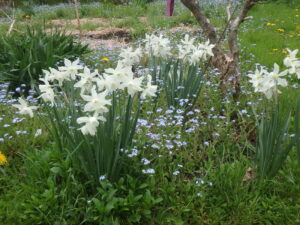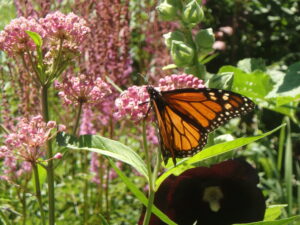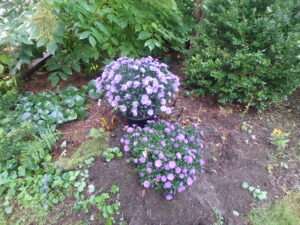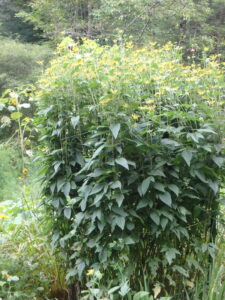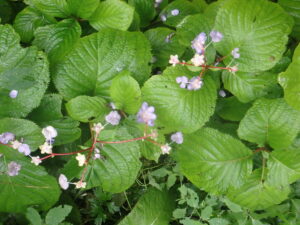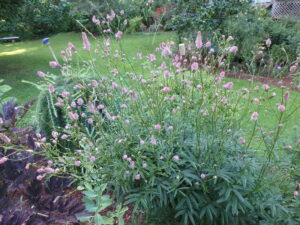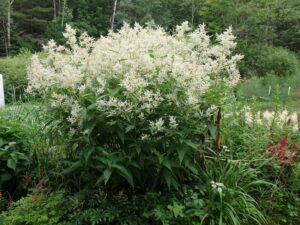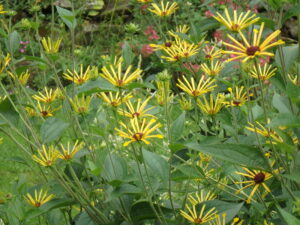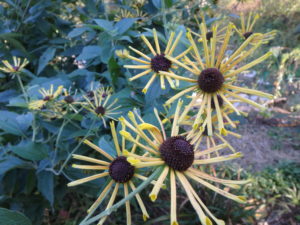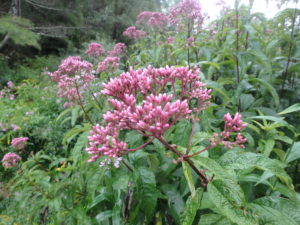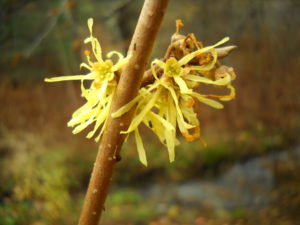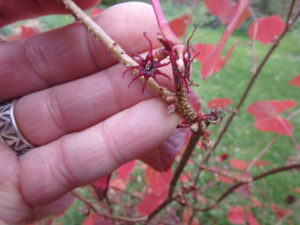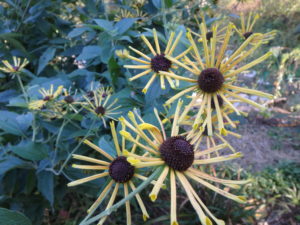Plants That Thrive in Wet or Moist Places
- The drumstick primrose (Primula denticulata) blooms in early spring in hues of blue to red or white. Then comes P. kisoana that spreads by root in either wet or dry places. Last, starting now, there is the candelabra primrose (P. japonica) which sets out a series of blossoms on an increasingly tall stem over a month of bloom-time. All love growing under old apple trees in dappled shade.
-
Forget-Me-Nots (Myosotis sylvatica). I have these blooming now by the hundred everywhere I look, sun or shade. These lovely low-growing blue (or sometimes pink or white) flowers self-sow bountifully. They prefer rich moist soil and will do well in sun or shade. Because they come back from seeds so easily we let them bloom, then often pull them out like weeds to plant something else.
- ‘Thalia’ daffodil. Most bulbs require good drainage, but ‘Thalia’ does fine in soggy soil. She is nearly white, and each bulb can produce three flowers at once. She blooms with the forget-me-nots. Order now for fall planting.
- Globeflower (Trollius spp.). An early summer bloomer, it does best in part sun and moist soil, but will also grow in ordinary garden soil and in full shade. The blossoms are an inch or so across, and bright yellow. Blooms in late May to June, but may sometimes re-bloom in the fall.
- Japanese iris (Iris ensata). These beauties will bloom in standing water, or in damp soil. They are like the Siberian iris, but their falls (petals) lay back almost flat. Blues and purples. Early summer.
- Cardinal flower (Lobelia cardinalis). These flowers are native plants the bloom on 3-foot stalks in fire engine red! I’ve seen them growing on the banks of the Connecticut River, but do well in moist soil and full sun in my garden. Will tolerate some dryness, but prefer wet. I avoid modern hybrids which are other colors, but not as hardy.
-
Swamp milkweed (Asclepias incarnata). Related to ordinary milkweed, this likes moist soil and full sun. Unlike the wild one, this does not send runners out and spread by root. Mine get 3- to 5-feet tall, and come in pink or white. Readily available at garden centers.
- These flowers come in red, pink and white and various heights. They can survive in drier soil in shade, but really love moist, rich soil and full sun. good cut flower with an almost woody stem.
- Goldenrod (Solidago spp.). There are many species, some of which spread by root, others do not. It is the very best perennial for supporting pollinators. Mid-summer to fall. ‘Fireworks’ is my favorite.
- Joe Pye Weed (Eutrochium purpureum). This is a native plant that thrives on stream beds and swampy areas that has bee domesticated. A cultivar known as ‘Gateway’ is the best, but gets to be over 6-feete tall. ‘Baby Joe’ is supposed to be a smaller version, but I haven’t tried it yet. Pollinators love this plant which blooms in fall with pinky-purple blossoms.
- Turtlehead (Chelone lyonii). Gorgeous tall stems loaded with pink flowers shaped like helmets – or turtle heads. Will do sun or shade, loves moisture but will grow in ordinary gardens, too. Bumblebees force themselves inside, and seem to growl in there at times. Great cut flower. Fall.
-
‘Henry Eiler’ Rudbeckia. One of the latest flowers I grow. Petals are distinctive: they have space between each one, like missing teeth. Tall, often 6-feet or more. Needs to be staked early, or perhaps cut back in early June to reduce height. Blooms past frost. Full sun, rich moist soil.
Do You Deserve a Medal?
I have lots of jewel weed (Impatiens capensis) in partly sunny to shady flower beds that have rich, moist soil. It is a native plant, but one that can take over if you let it. I recently removed some that was well over six-feet tall. It was in a bed with tall perennials, and I guess it outgrew them to get more sunshine, In other places, where the completion is minimal, it might only get 3- or 4-feet tall.
So what can you do with those empty spaces where you cut back flowers that have declined to the point that they needed to be cut back? Depending on the spacing, you might be able to fit in some chrysanthemums or fall asters. These are sold in bud or bloom in pots in grocery stores, farm stands and garden centers. They will bloom for weeks so long as you do not let them dry out. Fall asters are in the same category as the more common mums: inexpensive and lovely for filling in empty places.
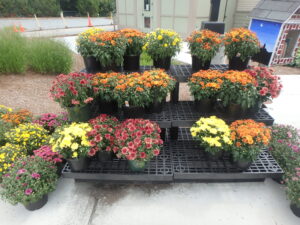
Chrysanthemums are nice fall annuals that will add color to your garden. They are readily available.
I can’t plant mums where I’ve cut back that big bleeding heart, for example as I would damage the roots if I dug there. But I can place them in a nice ceramic pot and set it gently in the same area as the bleeding heart, though perhaps a little forward or back from the stubs of the stems. Yes, it is work to do so, but it is worth the effort if you have it in a prominent spot that you (and your visiting friends and neighbors) will see.
Tall flowers are flopping over now, particularly if we get a heavy rain. I grow a black-eyed Susan, Rudbeckia ‘Henry Eiler’ that has gorgeous, unusual blossoms, but it grows to be over 6 feet tall. I surrounded the big clump with hardwood stakes a month ago and tied string from stake to stake to support it. Recently I tied another tier of string higher up on the 6-foot stakes to prevent flopping.
What about the lawn? By Labor Day it may be looking pretty shabby. I don’t believe any of us should waste water on our lawns. If you have a sunny yard with sandy soil, your lawn may be looking yellowed and dry. Crab grass, an annual that fills in where the lawn is compacted by foot traffic, is declining or dead by now in most places. My solution? Hope for rain, and try to avoid looking at the dead spots. Enjoy looking at that medal-worthy garden of yours!
Perennial Flowers That Like Moist Places
This year I have some new plants in my primrose garden given to me by a new friend and fellow garden writer, Judith Irven of Goshen,Vermont (https://
I have at least 4 other kinds of burnet, starting with a little one with variegated green and white leaves and deep maroon flowers (Sanguisorba officinalis var. microcephala ‘Little Angel’). I have others that grow 2-feet tall, and one that is 4 feet tall, both probably varieties of S. officianalis. The taller ones I tie up with stakes and strings by mid-July to keep them from flopping. A single plant will grow to be a big clump, taking a space four feet wide.
I am still looking for a burnet called ‘Lilac Squirrel’, a variety of S. hakusenensis. The name, and blossoms that resemble pink boas, are too outrageous not to want one. If you have one, please email a photo. Like all burnets, it likes moist soil and sunshine, from what I have read. It is hardy to Zone 5 – minus 20 in winter.
Another interesting genus is Persicaria, the fleece flowers. I have two species, P. polymorha or giant fleece flower and red bistort or mountain fleece (S. amplexicaulis). Giant fleeceflower makes a clump 6 to 8-feet tall and wide, with white blossoms a bit like astillbe blossoms – on steroids. The stems are an inch wide or more, but hollow like Japanese knotweed. The nice thing about it is that the flowers look good even after they have gone by, so 2 months of beauty is a given. Moving one is hard work, so plant it where you have plenty of space for it.
I have mountain fleece under the apple trees in my primrose garden, and the red bottle-brush flowers are just coming into bloom on 3- to 4-foot stems. The leaves are large, pointy and heart-shaped. Like its cousin, the bloom time is long: from now through much of the fall.
There are plenty of wildflowers that do well in moist shade. Prime among them are Jack-in-the-pulpit, red baneberry, trillium, and ramps. I grew up in Connecticut where there was skunk cabbage growing by our stream, and I bought a small clump some 25 years ago at The Garden in the Woods in Framingham, Mass. What a difference a couple of hundred miles makes. This early-spring bloomer has only recently achieved full size! I attribute that to the climate.
Many plants that grow well in ordinary garden soil will thrive in moist soil, too. I have Black-Eyed Susans (Rudbeckia spp.) that love my moist, sunny gardens but would be equally at home in drier soil. My favorite is Henry Eiler, one that blooms late and has very distinctive blossoms with the petals unnaturally far apart.
If you want to grow a shade-loving plant in a sunny location, you will have a better chance of success if the soil is also moist. Even then, not all succeed. But if you have space, and a willingness to experiment, your flowers may surprise you.
Henry lives in Cornish Flat, NH. His e-mail is henry.homeyer@comcast.net.
Fall Color in the Flower Garden
Big yellow buses are growling as they lumber down country roads, delivering their children to school. Soft serve stands are warning of imminent closure. Favorite flowers are finishing their blooms. Sigh. Fall is here. But don’t despair: there are plenty of colorful plants to fill vases and warm our hearts. Let’s look at a few I like.
Most of us have black-eyed Susans (Rudbeckia spp.) of some sort blooming now, either wild or planted. ‘Goldsturm’ is one of end most common, a nice one that has branched stems loaded with blossoms. But do you know one called ‘Henry Eiler’? It is much taller, and has narrow petals spaced out around the blossom, giving it an airy look. For me it blooms well into October. I have a big clump several years old, and need to tie it to keep the 5- or 6-foot stems from flopping. ‘Prairie Sun’ is wonderful one with a green eye that blooms consistently from July to after Halloween.
Turtlehead (Chelone lyonii) is one of my favorite fall bloomers. Each stem has numerous pink helmet-shaped blossoms an inch long that resemble, well, a turtle head. I love it in part, because it attracts bumblebees that force their way into the blossoms and disappear. I can hear them buzzing inside the blooms.
It does best in rich soil that is consistently moist to wet, but will grow in less desirable soil. I recently saw it on the Maine coast growing in hot, dry sandy soil, though it was much shorter than the 4-to5-foot stems I have. I grow it in full sun and also light shade, and each year the clumps get bigger. I never have trouble with it flopping, but have read that can be a problem in shady locations.
Joe Pye Weed (Eutrochium purpureum) is a native wildflower that appears alongside streams and in wet places. It can be grown in average garden soil, but if it is a dry location, some shade will help it. The small flowers are a pinky purple arranged in panicles that are about 6-inches across. The stems, a dark purple to almost black, contrast nicely with the deep green leaves.
Joe Pye weed is a big plant that requires lots of space. I have one clump that is now more than 8 feet tall, though 6 feet in average garden soil is more the norm. ‘Gateway’ is the best of the named cultivars, I think, but I have heard that a smaller variety called ‘Baby Joe’ is only 3 to 4 feet tall and 2 to 3 feet wide. I’m looking for one to try, as Gateway is too big for most beds. Moving a mature clump is almost impossible without a back hoe – or dynamite. I did it once, and won’t again.
When find a flower I like, I collect other species of the same genus. So it is with the burnets. First I planted Canadian burnet (Sanguisorba canadensis), our native species that grows by streams and wet places. It has white bottle-brush flowers on stems 4- to 6-feet tall in a wet area near my stream. It will bloom well into November.
Other burnets that I grow vary from a 6-inch tight cluster of variegated leaves and tiny burgundy blossoms to 6-foot tall plants with deep burgundy bottle-brush blossoms. Sanguisorba obtusa and S. stipulata are two of the species I grow, though the plant tags are long gone, so I’m not sure which is which. The foliage for most of the summer is very nice. I grow burnets in sun and rich garden soil.
Blooming now, obedient plant (Physostegia virginiana) is one of the least obedient plants I have grown. I have banished it to the edge of the woods in areas that would otherwise be just weeds. The pink or white flower spikes are great cut flowers, but the plant just won’t sit still. Its roots move fast, colonizing and pushing out well behaved plants. And it is tall: 3 to 8 feet!
The variegated form, however, is not a thug. It grows just to 3-feet tall; it does tend to flop, but it blooms later and doesn’t attempt to take over the world. It too, has pink flowers. Worth trying. Mine is yet to bloom this season.
Although I am a little far north to make my Arkansas amsonia (Amsonia hubrechtii) as big and bodacious as it is in places like Pennsylvania, it is still a great plant. Its steely blue flowers in June and July are nice, and the finely cut foliage is good all summer. But in the fall it excels: its leaves turn a lovely yellow that would make the plant worth growing, even without any flowers. Mine now stands nearly 3 feet tall and wide, and it gets even bigger in warmer locations.
Lastly I have to tip my hat to all those wonderful hydrangeas. Hybridizers have developed so many different named cultivars that I can’t keep track of them all. I’m not talking about the blue one, mysteriously called ‘Endless Summer’ which should be ‘Endless Disappointment’. It often fails to perform well after year one.
The classic PeeGee hydrangea has big white clumps of flowers that, if cut now, will look good in a dry vase all winter. And I love the pink ones like ‘Pinky Winky’ and ‘Pink Diamond’ (my personal favorite). ‘Limelight’ is a white blossom with green overtones, another great one.
So go to your local, family-run garden center and ask what they have that blooms now, and until late fall. Your garden doesn’t have to be dull now.
Next June I hope to help lead a Viking River trip down the Seine from Paris to Normandy. Interested? Just e-mail me at henry.homeyer@comcast.net. I’ll be giving garden talks in the evenings, and we’ll see Monet’s garden along the way.



